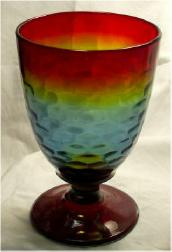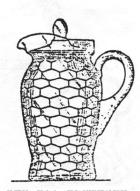Cambridge Rainbow - Rubina
by Lynn Welker
Issue 35 - March 1976
The winter weather has turned into bright sunshiny weather, so this month I'm offering a color that is prettiest in the sunlight - RUBINA.
Rubina is by far one of the most popular adore with Cambridge collectors and it ranks high on the ladder of rarity. This may be explained by the fact that it was not a good seller for Cambridge - which somewhat limited its production. It is well known that several retail firms returned their shipments of Rubina because it was unsaleable at the tine.
Rubina was first produced by the company in 1924 and introduced to
the trade in early 1925. The coloration of Rubina varies greatly. At
 the tine of its production first quality pieces were intended to shade
from red to green to blue to green. Some pieces may be lacking the blue
entirely while others may have additional blue on the edges due to the
reheating process. Some pieces may also lack the green and simply shade
from red to amber. The pieces with the blue and green coloration are
the most desirable. Production of Rubina was curtailed before 1930.
the tine of its production first quality pieces were intended to shade
from red to green to blue to green. Some pieces may be lacking the blue
entirely while others may have additional blue on the edges due to the
reheating process. Some pieces may also lack the green and simply shade
from red to amber. The pieces with the blue and green coloration are
the most desirable. Production of Rubina was curtailed before 1930.
Rubina comes in several optic patterns, the majority of which are block optic, honeycomb optic and wide optic. A few pieces have been seen in the narrow optic.
The block optic pieces known are several sizes of vases, tumblers
and a handled, covered pitcher (see drawing), which is considered very
rare.  The honeycomb
optic pieces known are a variety of different bowls and compotes in
many shapes and sizes as well as two types of covered candy compotes.
The wide optic pieces known are bowls, compotes, baskets, vases
(including the Sweetpea Vase from which the basket was made) and a
Lemonade pitcher and mugs, which are quite rare. The narrow optic
pieces known are all stemware pieces such as goblets, sherbets and
wines, all of which are very hard to find. Two sizes of candlesticks
with no pattern were also produced.
The honeycomb
optic pieces known are a variety of different bowls and compotes in
many shapes and sizes as well as two types of covered candy compotes.
The wide optic pieces known are bowls, compotes, baskets, vases
(including the Sweetpea Vase from which the basket was made) and a
Lemonade pitcher and mugs, which are quite rare. The narrow optic
pieces known are all stemware pieces such as goblets, sherbets and
wines, all of which are very hard to find. Two sizes of candlesticks
with no pattern were also produced.
The only patterned pieces known at this time are the Ram's Head bowl, Doric candlesticks, Dolphin candlesticks with the Mt Vernon or Stratford base and a very rare bowl in the Stratford pattern. Georgian tumblers in the 9 oz. size are known, but it is not clear if they were part of the Rubina production or time period. These Georgian tumblers do have beautiful Rubina coloring.
There are a variety of decorations to be found on Rubina. However, these decorations are very unusual and considered extremely hard to find. Decorations that I have seen on Rubina are platinum or gold edged borders, etched and gold encrusted borders and a sponged acid exterior decoration which was just recently found. Several of the bowls and compotes were available with mold-scalloped edges.
The majority of the Rubina bowls, compotes, and mugs are signed. However, due to the intense heating and reheating required for Rubina, the signature is sometimes obliterated. The candlesticks, stemware and Vases are not signed.
Rubina was the Cambridge factory name for this beautiful color. However, the workers called it Christmas glass and Watermelon glass. It has also been called Cambridge Amberina, but Rubina is the proper factory term for this color. If you have Rubina in your collection, you are indeed lucky. It is not only a popular color but a tempting and expensive one.
